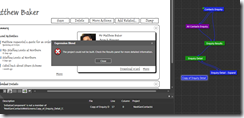In order return data from an MVC method, Microsoft provide a useful ActionResult object called JSONResult. JSONResult exposes a convenient Data property that you can use to serialize an object to JSON.
Here’s how it can be used:
var res = new JsonResult();
res.JsonRequestBehavior = JsonRequestBehavior.AllowGet;
res.Data = someObject;
return res;
Pretty easy to use. Unfortunately there’s no matching XMLResult class if you want to return a scrap of XML instead. In the MVCContrib project on codeplex there’s an XMLResult, but it’s event signature is slightly different.
I’ve modified this class to provide the same signature.
Here’s the usage:
var res = new XmlResult();
res.Data = someObject;
return res;
Here’s the class:
using System.Web.Mvc;
using System.Xml.Serialization;
namespace Sample
{
/// <summary>
/// Action result that serializes the specified object into XML and outputs it to the response stream.
/// </summary>
public class XmlResult : ActionResult
{
private object _objectToSerialize;
private XmlAttributeOverrides _xmlAttribueOverrides;
/// <summary>
/// Creates a new instance of the XmlResult class.
/// </summary>
/// <param name="objectToSerialize">The object to serialize to XML.</param>
public XmlResult()
{
}
/// <summary>
/// Creates a new instance of the XmlResult class.
/// </summary>
/// <param name="objectToSerialize">The object to serialize to XML.</param>
public XmlResult(object objectToSerialize)
{
_objectToSerialize = objectToSerialize;
}
/// <summary>
/// Creates a new instance of the XMLResult class.
/// </summary>
/// <param name="objectToSerialize">The object to serialize to XML.</param>
/// <param name="xmlAttributeOverrides"></param>
public XmlResult(object objectToSerialize, XmlAttributeOverrides xmlAttributeOverrides)
{
_objectToSerialize = objectToSerialize;
_xmlAttribueOverrides = xmlAttributeOverrides;
}
/// <summary>
/// The object to be serialized to XML.
/// </summary>
public object Data
{
get
{ return _objectToSerialize; }
set
{
_objectToSerialize = value;
}
}
/// <summary>
/// Serialises the object that was passed into the constructor to XML and writes the corresponding XML to the result stream.
/// </summary>
/// <param name="context">The controller context for the current request.</param>
public override void ExecuteResult(ControllerContext context)
{
if (_objectToSerialize != null)
{
var xs = (_xmlAttribueOverrides == null) ?
new XmlSerializer(_objectToSerialize.GetType()) :
new XmlSerializer(_objectToSerialize.GetType(), _xmlAttribueOverrides);
context.HttpContext.Response.ContentType = "text/xml";
xs.Serialize(context.HttpContext.Response.Output, _objectToSerialize);
}
}
}
}




















